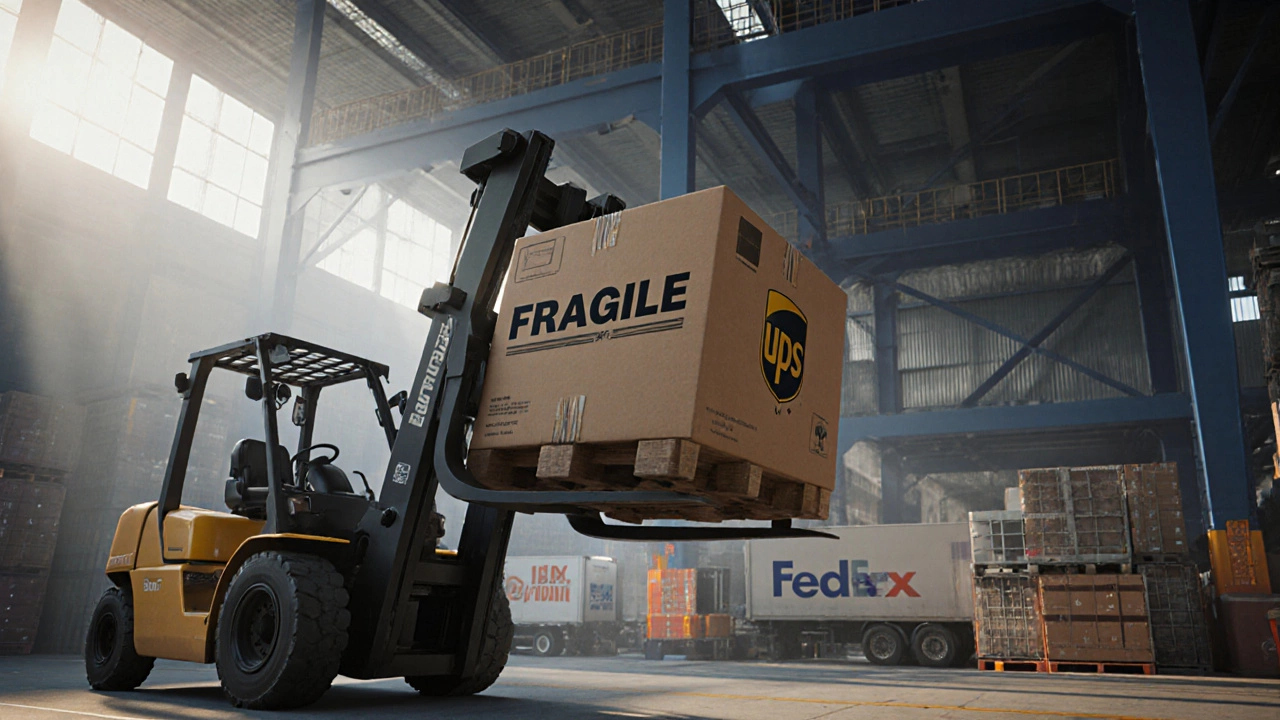International Shipping Cost Calculator
Calculate estimated shipping costs for a 100 lb box internationally based on destination, shipping speed, and dimensions. Note: Actual costs may vary based on carrier, customs, and other factors.
Shipping Details
Estimated Cost
Shipping a 100 lb box internationally isn’t like dropping a letter in the mail. It’s a whole different ballgame. You’re not just paying for postage-you’re paying for handling, customs, fuel, and the logistics of moving something that heavy across borders. If you’ve ever tried to ship a heavy box overseas, you know the sticker shock can be real. So how much does it actually cost? The short answer: anywhere from $300 to over $1,500, depending on where you’re sending it, how fast you need it, and who you use.
Why a 100 lb Box Costs So Much
Most people assume shipping cost is just weight × distance. But carriers don’t work that way. A 100 lb box is considered heavy freight, not standard parcel. That means it gets handled differently-from the moment it leaves your driveway to when it clears customs overseas.
Carriers like FedEx, UPS, and DHL have weight thresholds. Anything over 70 lbs usually gets routed to their freight division. That’s not the same as your regular overnight package. Freight moves on pallets, in trailers, and through dedicated terminals. It requires special equipment, trained staff, and more insurance. All of that adds up.
Then there’s dimensional weight. If your 100 lb box is big and boxy-say, 30 x 30 x 30 inches-the carrier might charge you based on volume, not actual weight. They calculate it by multiplying length × width × height, then dividing by a dimensional factor (usually 139 for international). In this case, that’s 27,000 ÷ 139 = about 194 lbs. So even though your box weighs 100 lbs, you’re billed for 194 lbs. That can double your cost.
Cost Breakdown by Carrier
Here’s what you can expect from the big three international carriers for a 100 lb box shipped from the U.S. or Canada to major global cities like London, Tokyo, or Sydney:
| Destination | FedEx International Freight | UPS Worldwide Saver | DHL Express |
|---|---|---|---|
| United Kingdom (London) | $750-$1,100 | $800-$1,200 | $900-$1,300 |
| Japan (Tokyo) | $900-$1,300 | $950-$1,400 | $1,000-$1,500 |
| Australia (Sydney) | $850-$1,250 | $900-$1,350 | $950-$1,400 |
| Mexico (Mexico City) | $400-$700 | $450-$750 | $500-$800 |
| Brazil (São Paulo) | $600-$1,000 | $650-$1,100 | $700-$1,200 |
These prices are for standard delivery (5-10 business days). If you need it in 2-3 days, add 40-60% to the cost. DHL tends to be pricier but more reliable for customs clearance in tricky regions like South America or Africa. FedEx often has better rates to Europe. UPS is middle-of-the-road but has wide coverage.
Freight Forwarders: The Hidden Alternative
What if you could cut your cost by 40%? That’s where freight forwarders come in. Companies like Flexport, ShipBob, or local brokers like those in Toronto or Vancouver don’t own planes or trucks-they bundle shipments from multiple customers to get bulk rates.
For a 100 lb box, a freight forwarder might quote you $400-$700 to send it to the UK, even if the big carriers charge $1,000+. How? They ship your box in a container with dozens of others. It’s slower-usually 2-6 weeks-but way cheaper. This works great for non-urgent items: machinery parts, furniture, bulk inventory, or personal belongings when moving abroad.
But there’s a catch. You’re responsible for customs paperwork. You’ll need to fill out commercial invoices, HS codes, and sometimes pay duties upfront. If you’re not familiar with export rules, you could get stuck at the border. That’s why many forwarders offer代办 (代办 means "代办" in Chinese, but in English context, it should be "assistance") services for an extra fee.
What You Can’t Ignore: Customs and Duties
Here’s where most people get surprised. The shipping cost you see online? That’s just the transportation fee. It doesn’t include taxes, tariffs, or import fees. Those are charged by the destination country.
For example, shipping a 100 lb box of electronics to the UK might cost $800 to deliver, but then you get hit with a 20% VAT on the value of the goods. If your box is worth $2,000, that’s $400 more in taxes. Same thing in Australia-10% GST plus possible duties on electronics or machinery.
Some carriers offer DDP (Delivered Duty Paid), where they collect all fees upfront. That’s easier, but the price is higher. DDU (Delivered Duty Unpaid) means you pay at the door. That’s cheaper upfront, but risky-if you don’t have the cash ready, your box gets held in customs for weeks.
How to Save Money
There are smart ways to cut costs without sacrificing reliability:
- Reduce box size. Pack tighter. Use void fill instead of empty space. A 20 x 20 x 20 inch box weighing 100 lbs will cost way less than a 30 x 30 x 30 inch one.
- Ship slower. Choose economy freight instead of express. A 10-day delivery can be half the price of a 3-day one.
- Use a forwarder. Especially for destinations like Brazil, India, or Southeast Asia where carriers charge high access fees.
- Consolidate. If you’re shipping multiple boxes, combine them into one pallet. You’ll pay less per pound.
- Check for discounts. Some carriers offer commercial rates if you ship regularly. Even if you’re not a business, ask. Sometimes they’ll give you a 10-15% discount if you mention you’re shipping for a nonprofit or educational purpose.
What Happens If You Underestimate?
Don’t guess your weight or dimensions. If your box is actually 110 lbs and you said 100, the carrier will reweigh it at their facility and bill you the difference-plus a $50-$100 handling fee. Same with dimensions. If your box is oversized, they’ll charge you for the next size up.
I’ve seen people try to save $20 by lying about weight. Then their box gets delayed for 3 days while the carrier calls them for payment. That’s not worth it.
Always weigh your box on a commercial scale. If you don’t have access, most shipping stores like The UPS Store or FedEx Office will weigh it for free. Get a receipt. Keep it.

Real Example: Shipping a 100 lb Box from Toronto to Berlin
Last month, a client in Toronto shipped a 100 lb box of vintage audio equipment to Berlin. The box was 24 x 24 x 24 inches. Actual weight: 102 lbs. Dimensional weight: 105 lbs. So they were billed for 105 lbs.
They used DHL Express with DDP. Total cost: $1,120. That included pickup, customs clearance in Germany, and delivery to the door. No surprise fees. The recipient didn’t pay a cent extra.
Same box, same destination, with a freight forwarder: $580. But delivery took 22 days. The client chose DHL because the equipment was needed for a trade show in 10 days. They paid more, but got reliability.
When to Skip the Big Carriers
Not every heavy box needs FedEx or DHL. If you’re shipping something bulky but not urgent-like a treadmill, a small engine, or a pile of books-consider ocean freight. You can ship a 100 lb box via sea freight for under $200, but it takes 6-10 weeks. That’s only worth it if you’re not in a rush.
Or if you’re moving overseas permanently, look into moving companies that specialize in international relocations. They’ll pack, ship, and even unpack your 100 lb box. It’s pricier than freight forwarders, but you don’t lift a finger.
Final Thoughts
There’s no single price for mailing a 100 lb box internationally. It’s a mix of weight, size, speed, destination, and how much risk you’re willing to take. The cheapest option isn’t always the best. The fastest isn’t always the smartest.
Know your box. Know your timeline. Know your budget. Then pick your method. Don’t just pick the first quote you see. Get at least three. Compare not just price, but what’s included. And always, always double-check the dimensions.
Shipping a heavy box isn’t a chore. It’s a logistics decision. Do it right, and you’ll save time, money, and stress. Do it wrong, and you’ll be waiting weeks for a box that’s stuck in a warehouse halfway across the world.
Can I ship a 100 lb box with USPS?
USPS doesn’t handle international shipments over 70 lbs. Even if you try to ship a 100 lb box, they’ll refuse it at the counter. For anything over 70 lbs, you need FedEx, UPS, DHL, or a freight forwarder. USPS International is only for small parcels and letters.
Is it cheaper to ship two 50 lb boxes instead of one 100 lb box?
Usually not. Carriers charge by total weight and dimensional weight. Two 50 lb boxes might have higher dimensional weight if they’re both bulky. Plus, you pay two handling fees. One 100 lb box is often more cost-effective. But if one box is oversized, splitting it might help avoid extra fees.
Do I need to insure a 100 lb box?
Yes, especially if it contains valuable items. Most carriers include basic coverage (up to $100), but that’s not enough for electronics, tools, or artwork. Add extra insurance-it costs 1-3% of the declared value. For a $2,000 box, that’s $20-$60. Worth it if something gets lost or damaged.
What documents do I need to ship a 100 lb box internationally?
You’ll need a commercial invoice that lists every item, its value, weight, and purpose (gift, sale, sample, etc.). You also need an export declaration if shipping from Canada or the U.S. Some countries require a certificate of origin or phytosanitary certificate for certain goods. Always check the destination country’s customs website before shipping.
How long does it take to ship a 100 lb box internationally?
Express services take 3-7 business days to major countries. Economy services take 7-14 days. Freight forwarding and ocean shipping take 3-8 weeks. Delivery time also depends on customs clearance. Some countries hold packages for days or weeks if paperwork is incomplete.





